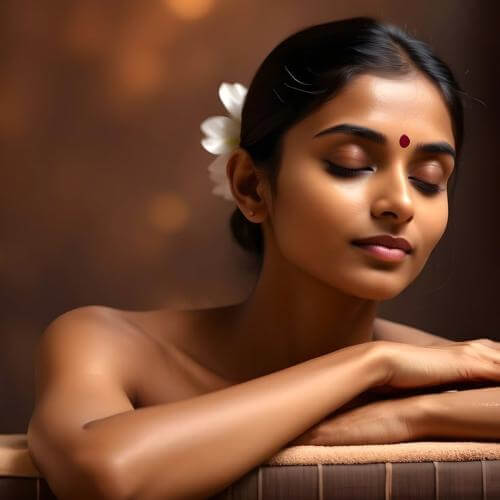
Ayurvedic medicine is a holistic approach to human health. Its treatments include oil therapies or snehana, which regenerate and rejuvenate the skin, reduce feelings of tension and stress, contribute to physical relaxation and mental health of all three doshas.
Some of the most well-known oil therapies (snéhana) include Abhyanga, a traditional 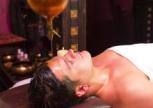 full-body oil massage that uses warm Ayurvedic oils with herbal extracts, Shirodhara therapy, where a continuous stream of warm oil is applied to the third eye (jnana chakra) area of the forehead, and Shirobasti therapy, or scalp oil bath.
full-body oil massage that uses warm Ayurvedic oils with herbal extracts, Shirodhara therapy, where a continuous stream of warm oil is applied to the third eye (jnana chakra) area of the forehead, and Shirobasti therapy, or scalp oil bath.
Abhyanga Full-body Oil Massage
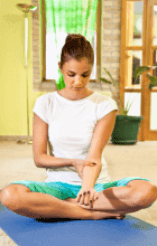 Regular body care in the form of self-massage with warm oil in the comfort of the home (abhyanga) soothes the doshas, flushes out toxins accumulated under the skin and contributes to the nourishment and regeneration of all seven bodily tissues (dhatus). It is an integral part of maintaining the balance of our individual doshic constitution, for which it is advisable to use Ayurvedic body oils for individual doshas (VATA body oil, PITTA body oil, KAPHA body oil). Their regular application regenerates and rejuvenates the skin, reduces feelings of tension and stress, contributes to physical and mental well-being, helps to improve the quality of sleep, promotes blood circulation and the lymphatic system, benefits joint function and stimulates vitality.
Regular body care in the form of self-massage with warm oil in the comfort of the home (abhyanga) soothes the doshas, flushes out toxins accumulated under the skin and contributes to the nourishment and regeneration of all seven bodily tissues (dhatus). It is an integral part of maintaining the balance of our individual doshic constitution, for which it is advisable to use Ayurvedic body oils for individual doshas (VATA body oil, PITTA body oil, KAPHA body oil). Their regular application regenerates and rejuvenates the skin, reduces feelings of tension and stress, contributes to physical and mental well-being, helps to improve the quality of sleep, promotes blood circulation and the lymphatic system, benefits joint function and stimulates vitality.
What Oils are Suitable for Holistic Self-massage at Home?
Ayurvedic massage therapy (abhyanga) involves applying warm oil to the entire body from the feet to the head area. Traditionally, sesame oil is primarily used, but flaxseed, coconut, neem, sunflower, castor, mustard or canola oil is also suitable, with the addition of plant extracts and essential oils from Ayurvedic herbs, depending on the individual doshic constitution of vata, pitta, kapha.
Sesame oil is one of the most important remedies in Ayurvedic medicine for its harmonizing effects on the irritated vata dosha, which is behind the disturbance of the other two doshas - pitta and kapha. It is rich in B vitamins and minerals such as iron, calcium, magnesium, copper, phosphorus, potassium, zinc and selenium. It contains many antioxidants, linoleic and alpha-linolenic acid and lecithin. Due to its antiseptic and detoxifying effects, it is beneficial not only for the good health of the skin tissue, but also for the nervous system, muscular activity, the joint apparatus and the overall strengthening of immunity.
To restore the overall balance of the body, we recommend always using one of the three types of Ayurvedic body oils: VATA oil, PITTA oil or KAPHA oil according to the individual constitution. The oils, with their rich composition of Ayurvedic herbs suitable for the dosha, easily penetrate the top layer of the skin to the subcutaneous tissue and then deeper to the nerve endings to the fascia of the connective tissue and have the ability to harmonize doshic imbalances. Also try them as part of Doshic Therapies along with Ayurvedic Doshic Tea, Chyawanprash Herbal Elixir to boost immunity and Dosha Nutrition Bar from Amla.
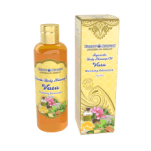
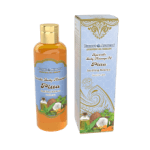
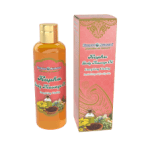 Don't you know your individual doshic constitution?
Don't you know your individual doshic constitution?
Fill out the doshic orientation test!
How and When to Perform Ayurvedic Oil Self-massage?
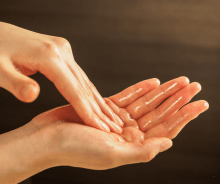 The best time to apply it daily is in the morning. Place the bottle in warm water, let the oil warm to a comfortable body temperature and then apply it to the skin. Using circular movements, rub the oil into the skin all over the body with feeling and attention. Massage first the hands and feet, then the limbs and joints, then the abdomen and chest, and finally the shoulders, neck, face, head and lumbar spine. Leave the oil on for 15 minutes and then take a shower with warm water. The warm bath helps to open the pores on the surface of the skin and allows the oil to penetrate even deeper below the surface of the skin into the body tissues. If you need to relieve tension and stress from the day or relieve the burning sensation in your eyes to prevent difficulty falling asleep or insomnia, massage at night before bed with extra care for your feet.
The best time to apply it daily is in the morning. Place the bottle in warm water, let the oil warm to a comfortable body temperature and then apply it to the skin. Using circular movements, rub the oil into the skin all over the body with feeling and attention. Massage first the hands and feet, then the limbs and joints, then the abdomen and chest, and finally the shoulders, neck, face, head and lumbar spine. Leave the oil on for 15 minutes and then take a shower with warm water. The warm bath helps to open the pores on the surface of the skin and allows the oil to penetrate even deeper below the surface of the skin into the body tissues. If you need to relieve tension and stress from the day or relieve the burning sensation in your eyes to prevent difficulty falling asleep or insomnia, massage at night before bed with extra care for your feet.
If you are going through a more challenging time in your life or have the following medical conditions, then skip regular self-massage: indigestion, constipation, colds, flu, fever, lymphatic infection, extremely high kapha dosha, menstruation and pregnancy.
"The body of a person who regularly performs oil massage is not much affected, even when subjected to accidental injuries or strenuous work. If a person performs oil massage daily, then he is endowed with a pleasant touch, good physical appearance, strength, charm and is not affected by old age."
- Charaka Samhita Vol. 1, V: 88-89
Other Types of Home Self-massage
Ancient Ayurvedic texts describe the benefits of full body oil massage (abhyanga) with emphasis on the health benefits of scalp, ear and foot massage. Because many important subtle pathways of consciousness (nadis) pass through these areas, connecting the flow of life energy (prana) to the network of vital energy points (marma) that influence the function of our body organs and systems, these areas require special care and attention.
The Ayurvedic surgical scripture (Sushruta-samhita) states that there are 107 marma points on the body that are the seat of the three life forces (prana, tejas, ojas) and contain information about our individual consciousness in the form of the relative representation of the three gunas (sattva, rajas, tamas). The stimulation of these points therefore affects the balance of the three doshas (vata, pitta, kapha), the function of the seven bodily tissues (dhatus) and the sixteen channels (srótamsí).
Scalp Oil Massage
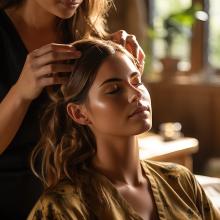
The scalp is the seat of the brain, nerve centre and sensory organs. Therefore, scalp massage (murdha taila) brings relief from mental tension, agitation and stress. It is performed for migraine, headache, insomnia, tinnitus, dizziness and vertigo. In case of acute tension in the head or eye area, you can perform a nostril oiling (navana-nasya), where you insert your little finger dipped in oil into the nostrils and perform a gentle massage.
Regular oiling of the scalp improves blood circulation to the hair roots. It promotes the health, shine and beauty of the hair and reduces greying or hair loss. Traditionally, the Ayurvedic oil BHRINGARAJ is used for this purpose, which acts as a tonic (rasayana) for natural nourishment, regeneration and hair growth.
Oil Massage of the Ears
The ears are an externally accessible organ, so sound, wind, dust and dirt constantly penetrate them. It is a good idea to perform ear oil cleansing (karna-pratisaranam) once a month or more often in case of excessive ear wax production, hearing loss, tinnitus or stiffness of the neck and jaw muscles, which are symptoms of disorders of the dosha vata and kapha, or ear canal inflammation in case of increased pitta dosha.
Apply a few drops of warm VATA oil or pure sesame oil to the ears with your pinky finger or cotton swab and gently massage the inner ear opening and then the entire outer ear. Massage the earlobe with your index finger on the front and thumb on the back of the ear. Knead the entire edge of the ear between your fingers and pull on the earlobe. Massaging the auricle in the morning or during the day brings a feeling of alertness and invigoration, and at night before going to bed induces a feeling of relaxation and deep rest.
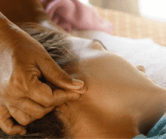 For chronically elevated vata dosha, ear pain, frequent inflammation, permanent tinnitus or hardened earwax, fill the entire ear with warm VATA oil or sesame oil (karna-purana) and lie on the right side for 15 minutes, then empty the oil from the ear. Do the same on the left side. Apply this method during the day before meals. Do not use ear oil if you have an acute or recurrent bacterial infection.
For chronically elevated vata dosha, ear pain, frequent inflammation, permanent tinnitus or hardened earwax, fill the entire ear with warm VATA oil or sesame oil (karna-purana) and lie on the right side for 15 minutes, then empty the oil from the ear. Do the same on the left side. Apply this method during the day before meals. Do not use ear oil if you have an acute or recurrent bacterial infection.
Foot Oil Massage
Abhyanga applied to the feet (padabhyanga) is a simple, pleasant and healthful massage. It is a very effective therapy for dry, corroded, cracked and numb skin on the feet. In Ayurvedic practice it is traditionally used for fatigue, muscle cramps, stiffness, sciatica and contraction of blood vessels or ligaments in the lower limbs. For sciatic nerve irritation, skillful stimulation of the reflex area at the heel of the foot brings considerable pain relief. 
Foot massage soothes eighty kinds of vata dosha disorders, relieves tension and stress, promotes mental balance and induces sound sleep. It has a beneficial effect on relaxing the nervous system that connects the head area to our feet, where the five important energy or marma points (talahridaya, kshipra, kurcha, kurchashira and gulpha) through which our life energy (prana) passes are located. Rubbing the feet in this way revitalizes the whole body and improves blood and lymphatic circulation.
There is a very close connection between the feet, eyes and ears. Therefore, by regularly massaging the feet, we can effectively prevent visual and hearing impairments. Rubbing the feet and ankles with warm sesame oil or VATA oil, PITTA oil, KAPHA oil or BHRINGARAJ oil is ideal to be done in the evening before going to bed as it promotes healthy sleep. According to Sushruta Samhita's text, it is sufficient to perform foot massage in a regular daily routine for 5 minutes to achieve the desired effects.
Massage technique performed on the foot
Apply oil to the entire foot. Massage both ankle bones in circular movements up and down the Achilles. Massage the front of the foot with both hands and then both arches. Gently pull and massage all the toes and then gently pull on each toe. Using a closed fist, knead the foot up and down. Massage the ball of the foot with both hands. Massage the heel. Gently circle the five marma points clockwise. Finally, rub the whole foot.
Belly Button oil massage
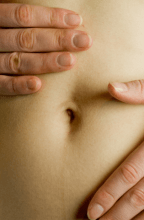 A part of holistic Ayurvedic massage is the application of medicated oil to the navel (nabhi-prakshepa), as this central area of the human body is one of the three most important centres of life energy (prana), along with the heart and brain, which are interconnected by a network of seventy-two thousand subtle pathways of consciousness (nadis). The navel is also functionally connected to the stomach and intestinal activities. Therefore, a gentle oil massage of the very center of the abdomen using the four fingers, helps to stimulate the power of the digestive fire (agni) and the flow of life energy (prana). This technique is used as part of health therapy for celiac disease and Crohn's disease, and also in cases of severe drop in blood pressure or sudden loss of consciousness.
A part of holistic Ayurvedic massage is the application of medicated oil to the navel (nabhi-prakshepa), as this central area of the human body is one of the three most important centres of life energy (prana), along with the heart and brain, which are interconnected by a network of seventy-two thousand subtle pathways of consciousness (nadis). The navel is also functionally connected to the stomach and intestinal activities. Therefore, a gentle oil massage of the very center of the abdomen using the four fingers, helps to stimulate the power of the digestive fire (agni) and the flow of life energy (prana). This technique is used as part of health therapy for celiac disease and Crohn's disease, and also in cases of severe drop in blood pressure or sudden loss of consciousness.
For navel massage you can again use VATA oil, PITTA oil or KAPHA oil according to your predominant doshic constitution.

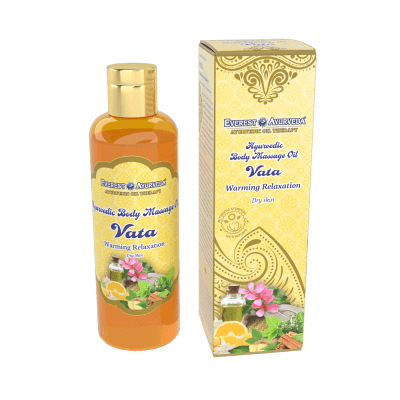 100 ml
100 ml 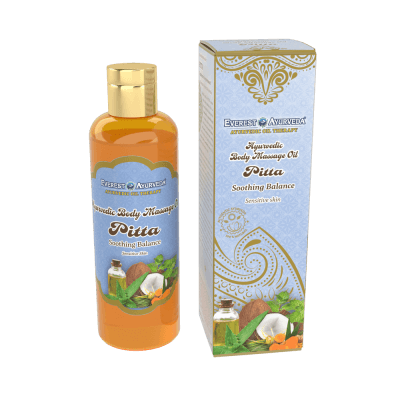 100 ml
100 ml  100 ml
100 ml 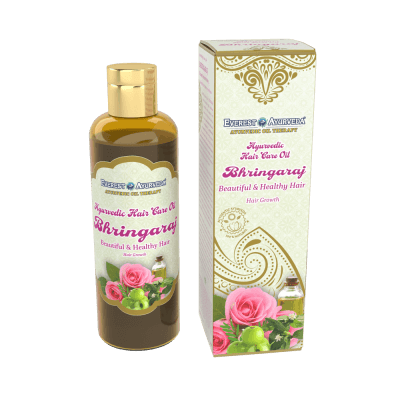 100 ml
100 ml  100 ml
100 ml 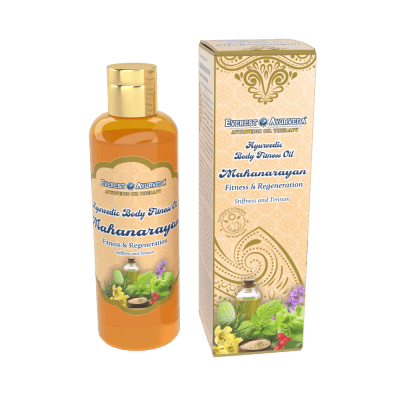 100 ml
100 ml